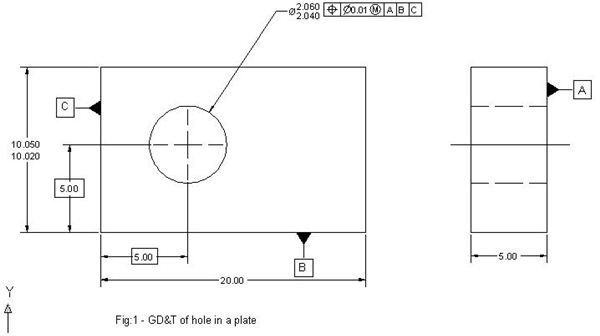Advanced Geometric Dimensioning and Tolerancing Tutorial – GD&T Application, Bonus Tolerance, ASME Rule
As a mechanical design engineer you might be pretty clear about the individual concepts of all the five categories of GD&T, but while applying practically the geometric dimensioning and Tolerancing symbols to your design, you may find the task bit challenging. The following points of the GD&T tutorial will help you strategize applicable tolerance for your design.
Key Points of GD&T Application
-
As soon as you are done with the 2D CAD drawing from the 3D CAD model, find out the feature of size dimensions,where GD&T need to be applied. The fig-1 below has a hole, for this purpose.
-
Next thing you have to do is to find out the sufficient numbers of datum. We have used three (A, B, and C). Though we have used the position tolerance symbol here, but the inclusion of datum A in the GD&T frame is ensuring the perpendicularity of the hole axis. So, from the above drawing, you will get the positional tolerance of 0.01 at MMC and perpendicularity tolerance at MMC of 0.01.
-
If a feature of size does not contain any GD&T symbol then the size as well as the form will be controlled by the specified size tolerance (Rule#1). In the above figure, the datum surface B and its opposite parallel surface is controlled by the dimension 10.050 – 10.020 and there is no GD&T symbol attached. So from the Rule#1 flatness of datum B should not exceed 0.03.
-
Whenever you are looking for a clearance fit, you should go for the MMC material modifier and if you use the LMC modifier with your GD&T value then the related fit will be interference fit.
-
Usage of MMC (or LMC) modifier with GD&T value, allows utilizing the bonus tolerance. In the Figure-1, GD&T is applied for MMC, means, for 2.040 diameter there should be a positional tolerance of 0.01 and as the diameter increases the positional tolerance also increase. For 2.060 diameter, the positional tolerance become 0.03.
Conclusion
The concept of geometric dimensioning and Tolerancing is important for a mechanical design engineer. Design engineers sometimes find it challenging for applying the GD&T practically. Datum selection basics, ASME Y 14.5 Rule#1, and the application of bonus tolerance become handy while dealing with the subject practically.
